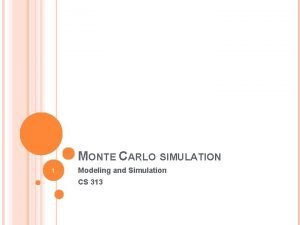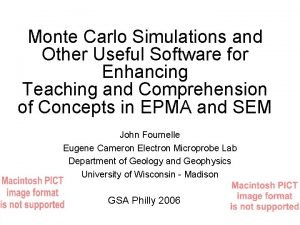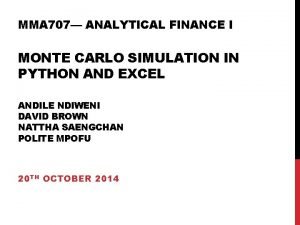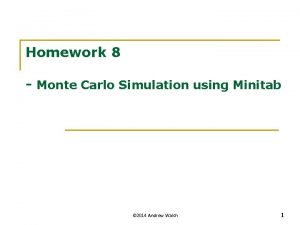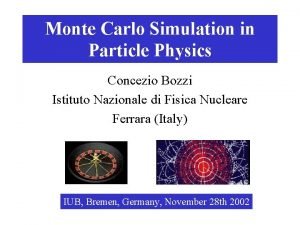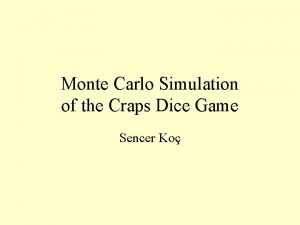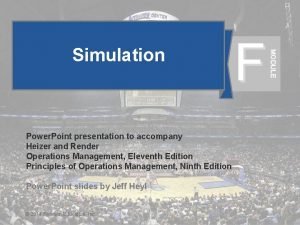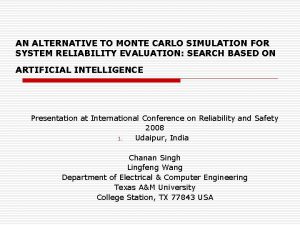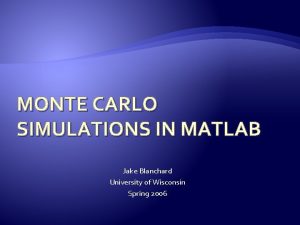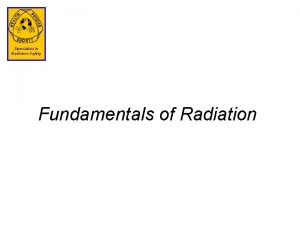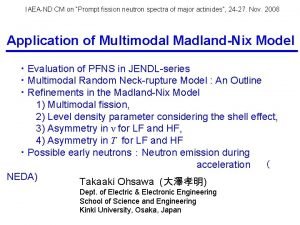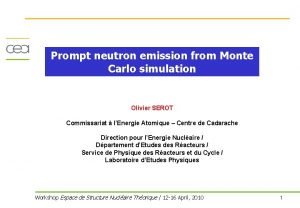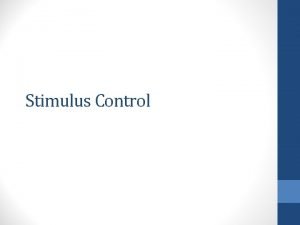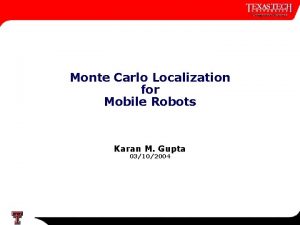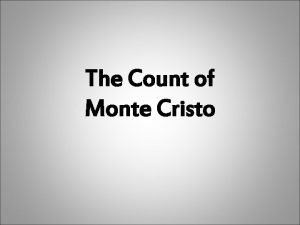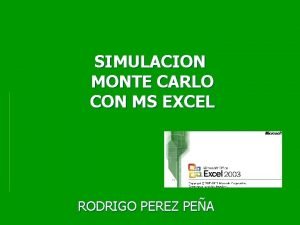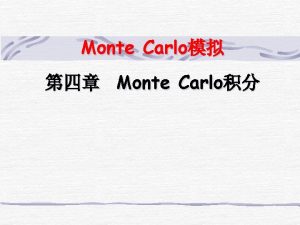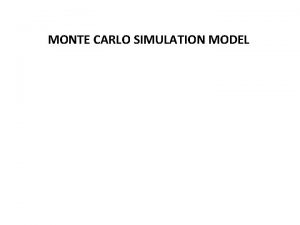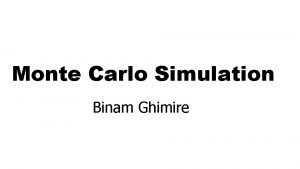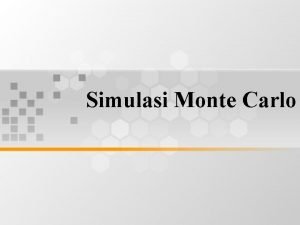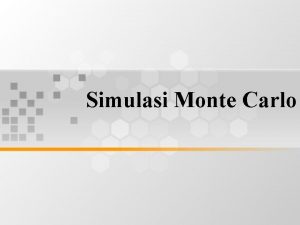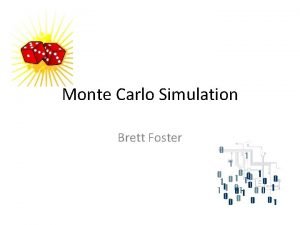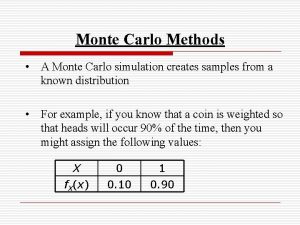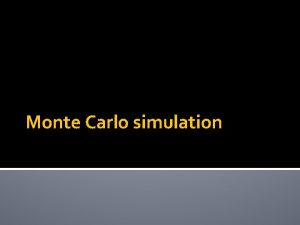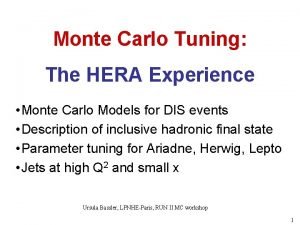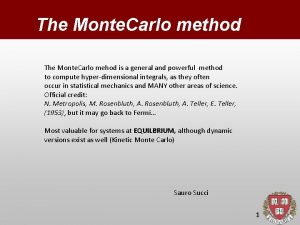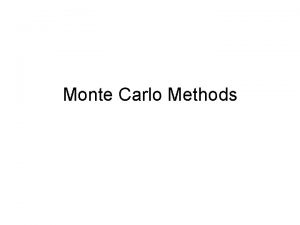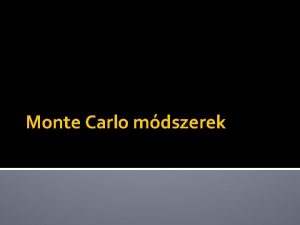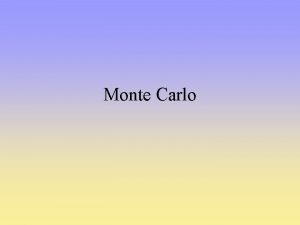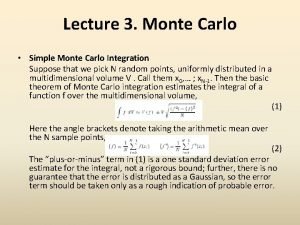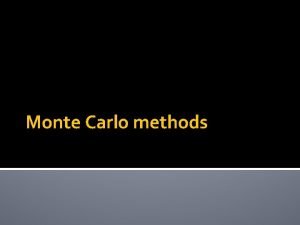Prompt neutron emission from Monte Carlo simulation Olivier













![Preliminary results n(A) (model G) Reasonable agreement except in the [155 -170] mass region Preliminary results n(A) (model G) Reasonable agreement except in the [155 -170] mass region](https://slidetodoc.com/presentation_image/44cf7628cf41664f8c03c4319ae8e3e6/image-14.jpg)




- Slides: 18

Prompt neutron emission from Monte Carlo simulation Olivier SEROT Commissariat à l’Energie Atomique – Centre de Cadarache Direction pour l’Energie Nucléaire / Département d’Etudes Réacteurs / Service de Physique des Réacteurs et du Cycle / Laboratoire d’Etudes Physiques Workshop Espace de Structure Nucléaire Théorique / 12 -16 April, 2010 1

Prompt neutron emission from Monte Carlo simulation 252 Cf(SF) Introduction Initial input data needed Calculation procedure Preliminary results Collaborations Olivier LITAIZE + Olivier SEROT / CEA-Cadarache / DEN Workshop Espace de Structure Nucléaire Théorique / 12 -16 April, 2010 2

Introduction Context • Prompt neutron and prompt gamma spectra and their multiplicities are very important data for nuclear applications • The evaluation files (JEFF, …) are not satisfactory (lack of data, same data for various fissioning nuclei…) Our aim is to develop a Monte Carlo code able to simulate statistical decay of the fission fragments: • Look at the physical quantities which can be assessed: n(A, TKE), P(n), Eg(A), N(e, A)…. • Test models related to the emission process Workshop Espace de Structure Nucléaire Théorique / 12 -16 April, 2010 3

Introduction Similar codes already exist: S. Lemaire et al. , [Phys. Rev. C, 72(2), 024601 (2005)]; Ø hypothesis H 1: RT=TL/TH=1: doesn’t work Ø hypothesis H 2: partitioning the excitation energy between the two fragments from experimenatl data: <n>(A), <e>(A) and <Eg>(A): less predictive • P. Talou et al. , [CNR 2009] RT values for each fission mode • Randrup and Vogt, [Phys. Rev. C 80, 044611, 2009 + Phys. Rev. C 80, 024601, (2009)] Workshop Espace de Structure Nucléaire Théorique / 12 -16 April, 2010 4

Initial input data / 252 Cf(SF) Y(A, KE, Z)=Y(A) × Y(<KE>, s. KE) × Y(Z) Allow to sample the mass, charge and KE of the fission frament Mass and KE distributions from Varapai’s thesis work Ionisation chamber NE 213 Thèse N. Varapai, Université Bordeaux 2006 Workshop Espace de Structure Nucléaire Théorique / 12 -16 April, 2010 5

Initial input data / 252 Cf(SF) Y(A, KE, Z)=Y(A) × Y(<KE>, s. KE) × Y(Z) Allow to sample the mass, charge and KE of the fission frament Mass and KE distributions from Varapai’s thesis work Nuclear charge distribution Charge dispersion: sz assumed independent of the mass Most probable charge taken from Walh evaluation: ZP From Wahl, Phys. Rev. 126 (1962) 1112 Workshop Espace de Structure Nucléaire Théorique / 12 -16 April, 2010 6

Calculation procedure 1 3 Sampling of the light fragment: AL , ZL , KEL 2 Then, the mass and charge of the heavy fragment are deduced: AH=252 -AL ZH=98 -ZL Its kinetic energy (KEH) is sampled on the experimental kinetic energy distribution AH , ZH , KEH The Total Excitation Energy (TXE) available at scission can be deduced: Total Kinetic Energy Total energy Total Excitation Energy Workshop Espace de Structure Nucléaire Théorique / 12 -16 April, 2010 7

Calculation procedure 4 Partitioning of the excitation energy between the two fragments At scission: TXE=Eint+Edef The main part of the deformation energy is assumed to be converted into intrinsic excitation energy (Ohsawa, INDS 251(1991)): ~10 -20 s ~10 -17 s n g g n scission fully acc. FF Ignatyuk’s model ~10 -14 s g n Neutron emission g g gamma emission Level density parameter Asymptotic level density parameter Effective excitation energy Shell corrections (Myers-Swiatecki, …) Workshop Espace de Structure Nucléaire Théorique / 12 -16 April, 2010 8

Calculation procedure 5 Neutron evaporation Weisskopf spectrum where T is the temperature of the residual nucleus: Energy limit for the neutron emission: Spin distributions (Vandenbosch – Huizenga) B= 8 forl LF B=9 for HF • Appoximation of the rotational energy • Erot allows to simulate competition neutron-gamma Inertia momentum Workshop Espace de Structure Nucléaire Théorique / 12 -16 April, 2010 b: Myers-Swiatecki 9

Preliminary results RT=TL/TH E*lim inertie <n>L <n>H <n>tot <E*>L <E*>H A 1. 00 Sn - 1. 82 2. 44 4. 26 15. 79 18. 11 B 1. 25 Sn - 2. 28 1. 93 4. 21 19. 64 14. 23 2. 05 1. 70 3. 76 - - Modèle Vorobyev et al. (2004) With model A: saw-tooth not reproduced and more neutrons from heavy fragment With model B: ratio n. L: n. H in better agreement with experiment Workshop Espace de Structure Nucléaire Théorique / 12 -16 April, 2010 10

Preliminary results Strong impact of the rotational energy: With rigid model: overestimation of the total neutron multilplicity With fluid model: completely wrong! Intermediate: satisfactory RT=TL/TH E*lim inertie <n>L <n>H <n>tot <E*>L <E*>H C 1. 25 Sn+EYrast Jrigid 2. 16 1. 85 4. 01 19. 65 14. 24 D 1. 25 Sn+EYrast Jfluid 1. 06 0. 46 1. 52 19. 66 14. 24 E 1. 25 Sn+EYrast 0. 4 Jrigid 1. 98 1. 71 3. 69 19. 64 14. 22 2. 05 1. 70 3. 76 - - Modèle Vorobyev et al. (2004) Workshop Espace de Structure Nucléaire Théorique / 12 -16 April, 2010 11

Preliminary results RT=TL/TH E*lim inertie <n>L <n>H <n>tot <E*>L <E*>H F RT(A)=0. 0116 A Sn+EYrast 0. 4 Jrigid 2. 08 1. 70 3. 78 19. 66 14. 28 G RT(A) Sn+EYrast 0. 4 Jrigid 2. 06 1. 70 3. 76 19. 89 14. 27 2. 05 1. 70 3. 76 - - Modèle Vorobyev et al. (2004) Model F (test) RT=TL/TH Model G: Workshop Espace de Structure Nucléaire Théorique / 12 -16 April, 2010 12

Preliminary results n(A, TKE) (model G) Workshop Espace de Structure Nucléaire Théorique / 12 -16 April, 2010 13
![Preliminary results nA model G Reasonable agreement except in the 155 170 mass region Preliminary results n(A) (model G) Reasonable agreement except in the [155 -170] mass region](https://slidetodoc.com/presentation_image/44cf7628cf41664f8c03c4319ae8e3e6/image-14.jpg)
Preliminary results n(A) (model G) Reasonable agreement except in the [155 -170] mass region Workshop Espace de Structure Nucléaire Théorique / 12 -16 April, 2010 14

Preliminary results n(TKE) (model G) Reasonable agreement except in the very high TKE energy Contributions of the light and heavy fragment needed to understand the n(TKE) behaviour Workshop Espace de Structure Nucléaire Théorique / 12 -16 April, 2010 15

Preliminary results <e>(A) (modèle G) Workshop Espace de Structure Nucléaire Théorique / 12 -16 April, 2010 16

Preliminary results P (n) model G Modèle G: Vorobiev: Reasonable agreement Léger n n Modèle G Total Lourd n RT=TL/TH E*lim inertie <n>L <n>H <n>tot <E*>L <E*>H RT(A) Sn+EYrast 0. 4 Jrigid 2. 06 1. 70 3. 76 19. 89 14. 27 2. 05 1. 70 3. 76 - - Vorobyev et al. (2004) Workshop Espace de Structure Nucléaire Théorique / 12 -16 April, 2010 17

Preliminary results Energy spectrum in the lab. (modèle G) Maxwellienne (T=1. 42 Me. V): Modèle G: <E> = 2. 13 Me. V (Budtz) <E> = 2. 20 Me. V (modèle G) Workshop Espace de Structure Nucléaire Théorique / 12 -16 April, 2010 18
 Equilikely
Equilikely Monte carlo simulation freeware
Monte carlo simulation freeware Monte carlo simulation
Monte carlo simulation Monte carlo minitab
Monte carlo minitab Monte carlo simulation particle physics
Monte carlo simulation particle physics Monte carlo simulation dice roll matlab
Monte carlo simulation dice roll matlab Monte carlo simulation advantages and disadvantages ppt
Monte carlo simulation advantages and disadvantages ppt Monte carlo alternatives
Monte carlo alternatives Doe minitab
Doe minitab Monte carlo method matlab
Monte carlo method matlab Beta minus decay
Beta minus decay Neutron emission
Neutron emission Actinides
Actinides Olivier prompt
Olivier prompt Discrimination stimuli
Discrimination stimuli Response prompt vs stimulus prompt
Response prompt vs stimulus prompt Monte carlo localization for mobile robots
Monte carlo localization for mobile robots Count of monte carlo
Count of monte carlo Distribución lognormal en excel
Distribución lognormal en excel
